When raised bumps or spots appear on your new baby’s previously perfect skin, it can cause concern – especially so as cow’s milk protein allergy symptoms (and others) become more common. But does your infant have baby acne, baby milk spots, or milk rash – and what’s the difference between them? This post will be looking at milk spots vs CMPA rash, milk allergy vs baby acne, milia vs milk allergy, and everything in between, plus reflux vs milk allergy babies.
What You’ll Find on This Page…
- What’s the Difference Between Baby Acne, Milk Spots, and Milk Rash?
- Milk Spots Baby Rash, Also Known as Milia
- Milk Spots vs Baby Acne vs Rash
- Baby Acne
- Baby Acne vs Milk Allergy
- Dairy Allergy Milk Rash vs Milk Spots
- Baby Acne vs Milk Spots vs Milk Allergy Comparison Table
- Reflux vs Milk Allergy Babies
- Caring For Milk Allergy Babies
- Looking After Baby’s Skin: Treatment for Baby Acne, Milia, or Milk Rash Caused By an Allergy
- Milk Rash FAQ’s
What’s the Difference Between Baby Acne, Milk Spots, and Milk Rash?

When your tiny infant presents with any kind of blemish, it can be worrying for new parents. This guide should help you to identify whether your baby is presenting with milk spots, an allergy rash, or baby acne.
One is thought to be hormonal, one a response to the environment outside of the womb, and one an allergy reaction. But which is which, and how serious are they?
This post will help you identify and distinguish between these three infant skin complaints.
Milk Spots Baby Rash, Also Known as Milia
What Are Newborn Milk Spots?
What are milk spots on babies?
Firstly, if you’re researching milk spots vs milia, they are the same thing. Milia are tiny white bumps that appear on the face, typically on your baby’s nose, chin, and cheeks, although they can also develop on the chest, upper arms, and legs.
Sometimes they can appear in and around the baby’s mouth and oral milia are known as Epstein pearls.
Milia often mistakenly referred to as baby acne or milk rash, which are not the same, however it’s worth noting that they may occur together.
Milia Symptoms: What Do Milia Look Like?
What do milk spots look like? Milia have a distinctive appearance and are often called baby milk spots because of their appearance – they resemble a spray of milk on the face – and the fact they most commonly occur in newborn babies. However, they’re not linked to either breastfeeding or formula.
Milia often mistakenly referred to as baby acne or milk rash, which are not the same, however it’s worth noting that they may occur together.
The following image is a classic representation of milk spot rash. Milk spots across the bridge of the nose are a very common condition, as you can see in the following example.
Milk spots in a newborn baby:
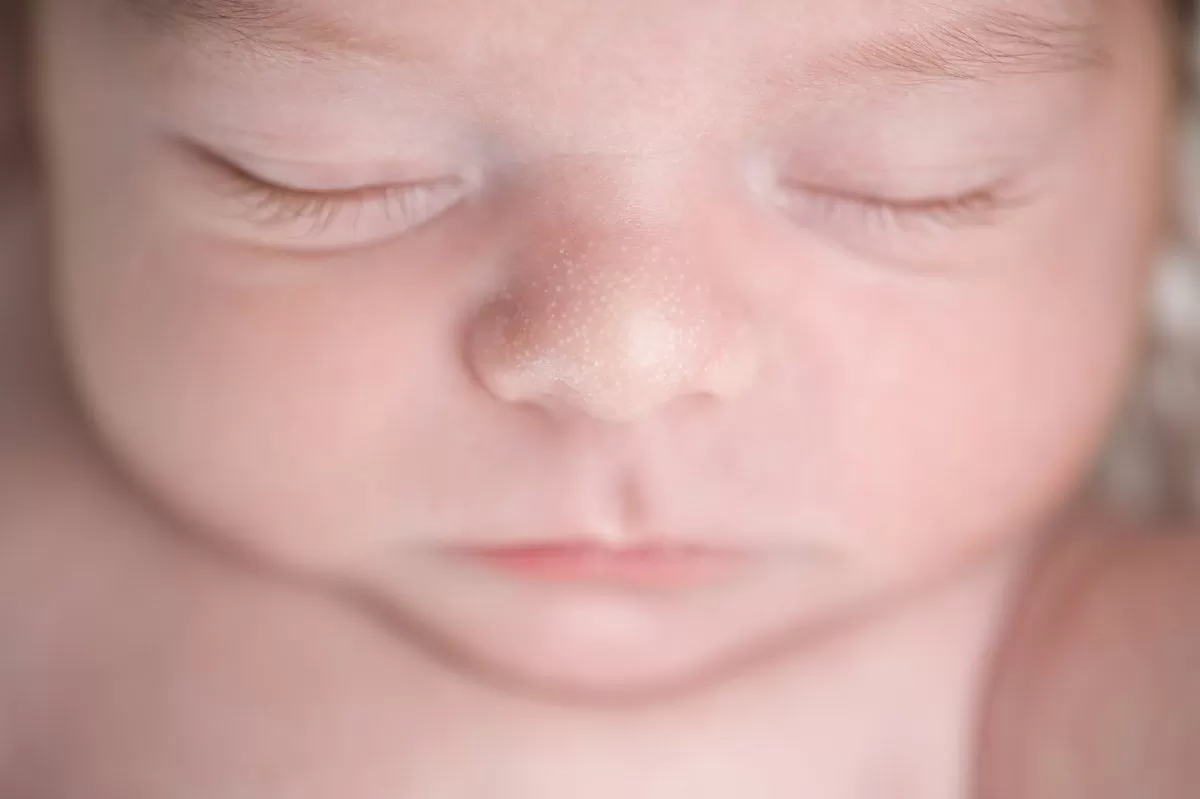
The white spots or bumps are deep under the skin and do not have the typical redness or swelling associated with whiteheads.
What Causes Milia Baby Spots?
Milia in babies are caused by flakes of dead skin cells becoming trapped in pockets under the skin, and this is what causes milk spots.
They are unrelated to how the baby is fed, or the mother’s diet if breastfeeding.
How Serious is Milia?
Are milk spots bad for your baby? You’ll be relieved to know that Milia and Epstein pearls (milia located on the roof of the mouth and gums) are common and completely harmless. They usually disappear within three months of birth.
Milia baby spots can affect older children and adults, though there’s usually a cause, such as injury or inflammation.
How to Get Rid of Milk Spots
If you’re concerned and worrying how to get rid of milk spots on baby, rest assured there’s no need to do anything more than keep your infant clean – certainly picking milk spots is not advised as this can both cause your baby pain and introduce bacteria.
They are unrelated to how the baby is fed, or the mother’s diet if breastfeeding.
Milia should disappear naturally within a few weeks or months of birth.
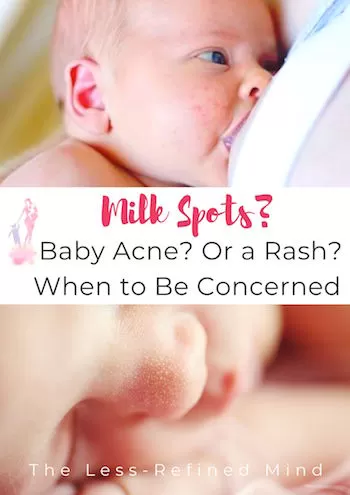
Do I Need to See a Doctor About Milia?
There’s no need to see a GP unless you have specific concerns or the little bumps worsen or remain after the few months of life.
Milk Spots vs Baby Acne vs Rash
When it comes to milia vs baby acne or a rash, it can be difficult to know whether the condition your infant is displaying with is harmless, or something to be more concerned about.
If you’re not convinced the skin complaint your baby is displaying with is milia, read on to see whether baby acne is more likely…
Baby Acne
What Is Baby Acne?
Affecting around 20% of babies, baby acne (also known as neonatal acne) is common. Occasionally baby acne can be present at birth, however it more commonly develops in the first few weeks of life.
Health professionals believe baby acne may be caused by the maternal hormones surging through the mother’s body around the time of birth.
Baby Acne Symptoms: What Does Baby Acne Look Like?
Unlike milia, baby acne presents as small spots or whiteheads on the surface of the skin, usually on your baby’s cheeks, though it can appear anywhere on the face. Unlike infantile acne, baby acne does not usually appear as blackheads.
Here’s an example:
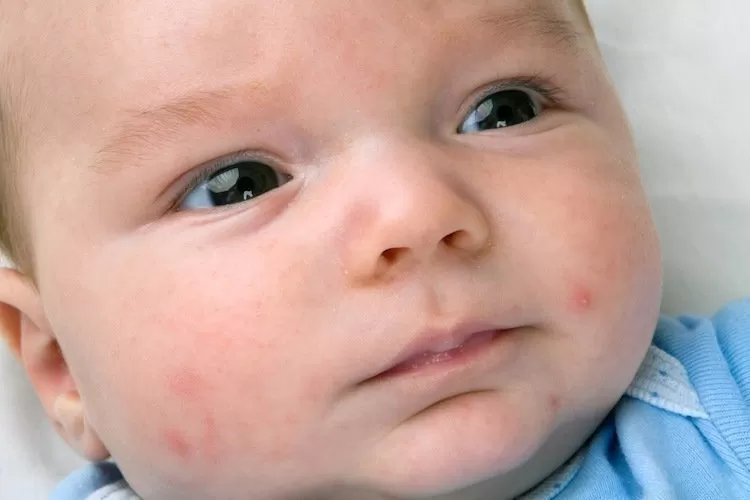
The affected area may be a little red and irritated, and fussing or crying may make the acne more pronounced. Baby acne can sometimes also develop on the upper back and neck.
What Causes Baby Acne?
Health professionals believe newborn acne may be caused by the maternal hormones surging through the mother’s body around the time of birth.
How Serious is Baby Acne?
Unlike infantile acne which is less common and more complicated, baby acne is harmless and usually resolves itself within a few weeks or months.
Infantile acne can remain until toddlerhood and if left untreated, in rare cases may result in scarring. If you have specific concerns about your baby’s acne see your GP or a pediatric dermatologist.
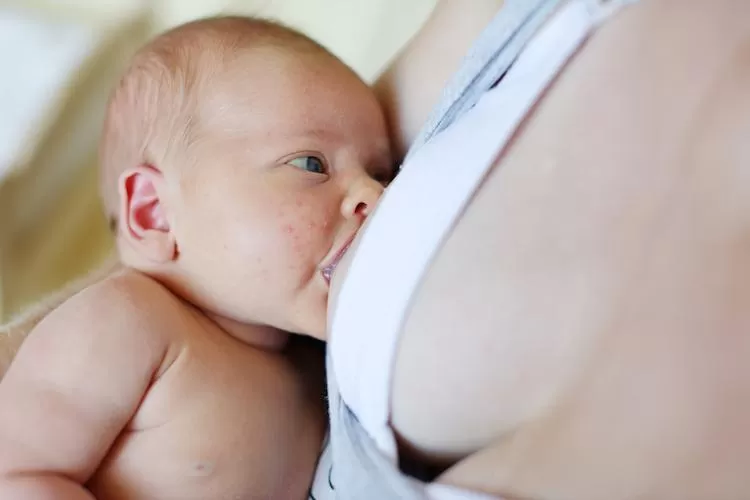
Do I Need to See a Doctor About Baby Acne?
You don’t need to see a GP unless you have specific concerns or the spots worsen or remain by a few months of age.
Also note that prickly heat rash can be confused for baby acne.
Baby Acne vs Milk Allergy
If you’re looking at symptoms of baby acne vs CMPA rash and you’re still concerned that your child’s rash stems from a more serious issue, read on to find out how to identify baby acne or allergy in your infant.

Dairy Allergy Milk Rash vs Milk Spots
Some people incorrectly use these terms interchangeably; milk spots (milia) are harmless, while an allergic milk rash should not be ignored. Read more about breastfeeding with CMPA.
What Is a Baby Milk Allergy Rash?
Baby milk allergy rash occurs as a result of exposure to an allergen and is usually apparent by a couple of weeks of age. CMPA, or cow’s milk protein allergy is one of the most common allergies in infants.
CMPA affects around 2-3% of babies, but it’s much rarer for baby’s to react through breastmilk than direct exposure via formula (around 0.5%).
CMPA is caused by an abnormal response to cow’s milk protein by the immune system.
What Does Cow’s Milk Allergy Rash Look Like?
CMPA rash vs baby acne is quite apparent when you know what to look for.
An infant milk rash caused by a dairy allergy, looks like severe acne. The rash is often angry and extensive, creeping beyond the hairline and onto the ears.
Eliminating the allergen from the infant’s diet will allow the rash to heal and disappear.
Milk rash, caused by a dairy allergy:
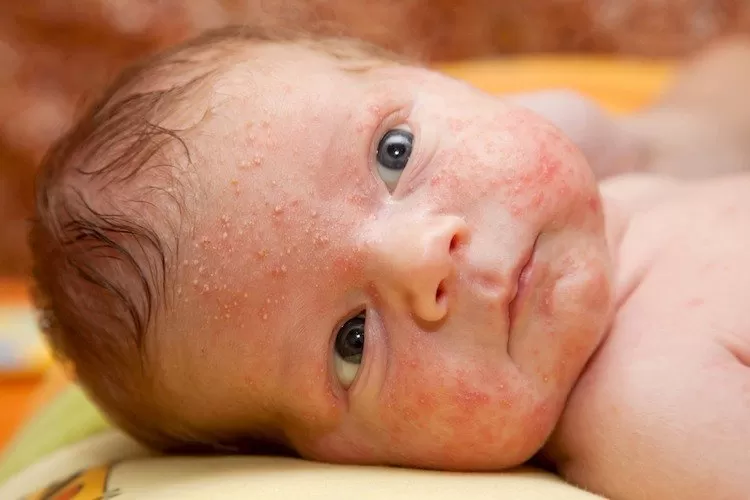
What Causes a Milk Rash?
CMPA is caused by an abnormal response to cow’s milk protein by the immune system.
How Serious is Cow’s Milk Allergy Rash?
The seriousness of the rash relates to the allergy, as opposed to the superficial aspect of the rash itself. Allergies vary in severity, but should not be ignored. More information on identifying and managing CMPA.
Do I Need to See a Doctor About CMPA?
It’s recommended to seek help from a dietitian who specialises in allergies once diagnosis is confirmed. Referral is via your GP.
Baby Acne vs Milk Spots vs Milk Allergy Comparison Table
| Milk Spots / Milia / Epstein Pearls | Baby Acne | Cow’s Milk Allergy Rash | |
| Appearance | Tiny bumps, white in colour, usually on the face. (Example above.) | Small spots or white heads. (Example below.) | Similar to severe acne, often angry and extensive. |
| Cause | Flakes of dead skin becoming trapped in pockets under the skin. | Maternal hormones surging through the mother’s body around the time of birth. | Allergy to the protein in dairy products. |
| Severity | Cosmetic only. | Cosmetic only. | Indication of allergy. |
| Prognosis | Temporary. | Temporary. | Will dissipate with elimination of allergen from the diet. |
Reflux vs Milk Allergy Babies
Another symptom you may see if your baby has an allergy is reflux, as well as other gastro symptoms. Take a look at my post all about milk allergy symptoms for the full list.
What is Reflux?
Reflux is when your infant brings up their milk. You may also notice gagging, coughing, difficulty feeding, nasal congestion, and breathing problems, such as wheezing.
If the symptoms are similar but without spitting up, your baby may be experiencing silent reflux, where they swallow any regurgitated milk.
Both of these conditions can be caused by an allergy, and may result in poor weight gain.
Caring For Milk Allergy Babies
If you suspect your baby is suffering from a food allergy, you may like to keep a food diary to help confirm, particularly if you suspect multiple allergens or if your baby is being cared for outside of the home.
Cow’s Milk Allergy Rash – Breastfed Babies
I’ve created an allergy food diary specifically for breastfeeding mothers of allergy babies, to help you record, track, and analyse data. This is especially helpful for when you begin dairy free weaning, or if your baby is cared for outside of the home.

Available exclusively to subscribers to download for free from the resources library.
Looking After Baby’s Skin: Treatment for Baby Acne, Milia, or Milk Rash Caused By an Allergy
Although blemishes on your infant’s face may be unsightly and undesirable, in most cases they are completely harmless and require no medical treatment. However, newborn skin = sensitive skin, so it’s important to care for it appropriately.
This is not true of allergies which require attention and support from health professionals.
To best care for your baby’s delicate skin:
- Keep the face clean – gently wipe away milk, spit up, and vomit promptly;
- Be gentle – avoid using harsh chemicals or scented products which may irritate the skin – warm water is usually adequate, and pat, don’t rub dry;
- Leave spots alone – don’t squeeze or scrub your newborn’s skin as this may aggravate skin conditions.
Milk Rash FAQ’s
Here are some common questions related to cows’ milk allergies.
Can a dairy allergy cause milk allergy baby rash on face?
Yes, the face is often where an allergy rash starts. From there, the rash may develop and spread outwards from your baby’s face until the allergen is removed from the diet (including mother’s if breastfeeding).
Once the allergen is eliminated, you should see a marked improvement within several days (around 3-5), and a gradual reduction and ceasing of all symptoms over a few weeks (it takes three weeks for the allergen to leave the mother’s body, and another three weeks to leave baby’s system).
If symptoms continue after this time, you may be dealing with multiple allergies. In this case, keeping a food diary can be helpful to help identify other potential allergens.
What is a milk rash?
The term ‘milk rash’ is used to mean two different things. Some people call baby rashes caused by pooled milk that’s not wiped away milk rash.
In the context of this article, milk rash refers to the topical allergic symptoms caused by a cow’s milk allergy.
Can milk cause skin rashes?
Yes, if your baby’s immune system recognises cow’s milk proteins as an allergen then it can result in a mild reaction, ie. skin rashes, and in some cases a more severe reaction such as difficulty breathing.
Other common symptoms of CMPA include runny nose, cradle cap, diaper rash, atopic eczema or atopic dermatitis, and stomach cramps.
How do you treat a milk rash?
If your baby’s symptoms include a skin condition caused by CMPA, it will be necessary to remove food allergens from your baby’s diet in order to stop symptoms.
An elimination diet will also apply to breastfeeding mothers, and it’s important to check food labels for everything, every time.
This is because many common foods contain a small amount of milk, and it can hide in the most unpredictable ingredients, such as ham, crisps, and wine.
Note also that ingredients lists can change without warning, so previously safe foods can become milk products unexpectedly.
Milk allergies usually resolve by the end of the first year of life. If you baby is a good candidate you can challenge the allergen at around this time and then monitor your baby for reactions.
The desired outcome will be that your child is able to tolerate milk, so it can be slowly reintroduced into their diet.
You may also be interested in our milk ladder challenge FAQ’s.
It’s recommended that you only attempt this challenge under the guidance of your health care provider.
What’s the different between IgE and non-IgE Mediated CMPA?
IgE-mediated milk allergies are when the immune system reacts to an allergen, in this case the protein found in cow’s milk, by producing IgE antibodies which subsequently trigger an allergic reaction.
An IgE-mediated reaction occurs within minutes to a couple of hours after exposure and can cause skin reactions as well a more severe allergic reaction such as trouble breathing.
Since anaphylaxis can be a rare but extreme symptom of allergies, breathing problems should always be treated as an emergency, and urgent medial attention sought.
Symptoms of non-IgE mediated CMPA take longer to appear, from a few hours to several days after exposure, and may be less severe. This can make diagnosis tricky, because symptoms can be mistaken for a viral infection or other cause.
How do you confirm a cow milk allergy?
While a blood test or skin prick test will pick up on IgE mediated CMPA, it will not diagnose a non-IgE mediated allergy.
For this reason, the gold standard for confirming a milk allergy is an elimination diet and subsequent food challenge.
I know you can find a milk allergy baby rash on the face, but where else does it appear?
Correct, a common first symptom is the milk allergy baby rash on the face. But from there it can creep into the hairline, onto your baby’s scalp and ears, and down the neck.
If your baby has hives as a reaction to dairy, the resulting wheals can show up anywhere on the body.
If symptoms worsen or appear to distress your baby, or if you have any other concerns, always see your health visitor or GP for medical advice.
